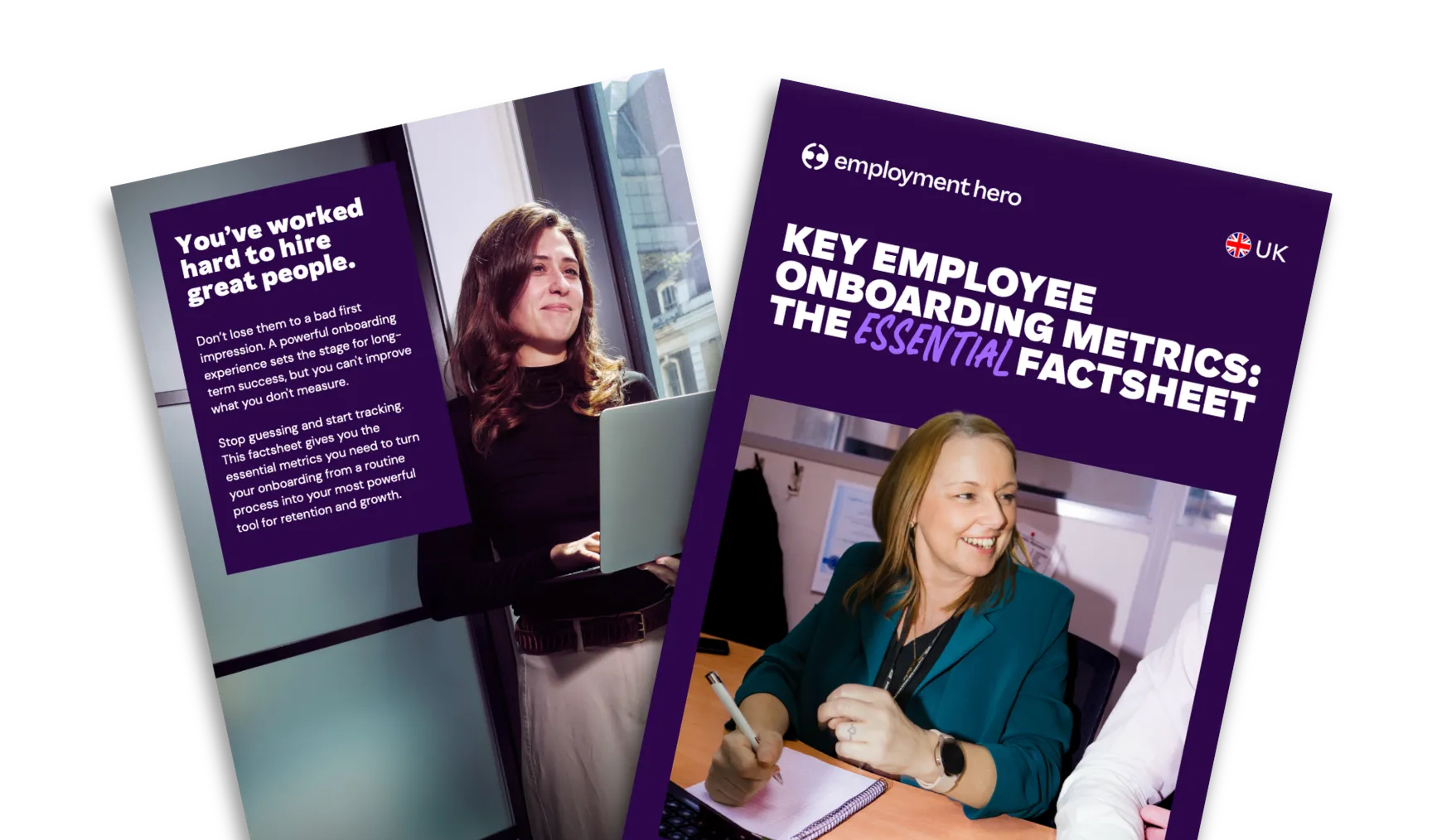How to coach employees to develop their potential
Published
How to coach employees to develop their potential
Published
Coaching employees is one of the most powerful ways of supporting your team and driving business growth. But the reality is, good leadership isn’t always easy. Gone are the days where managers barked orders and workers complied. No – great leadership isn’t about giving orders, it’s about unlocking potential. And in today’s dynamic world of work, great leaders don’t just manage; they focus on mentoring.
Development and growth create an environment where your team builds confidence, feel empowered to solve challenges and take real ownership of their role and continuous learning. When leaders mentor instead of control, they inspire innovation, trust and high performance.
We’ll dive into the fundamentals of coaching employees, outlining how you can mentor with purpose, nurture talent and help both your team and business achieve new levels of success.
The importance of coaching employees
Coaching employees is not a “nice-to-have” HR initiative; it’s a powerful driver of business performance. And it’s also not just about improving performance, it’s about unlocking potential and improving engagement.
So here’s exactly why employee coaching matters:
- It drives engagement and motivation. Employees who feel supported and developed are more engaged, energised and committed to their work. In fact, our Work That Works report states that job satisfaction is the strongest correlating factor for productivity. Coaching helps people see how their growth connects to the bigger picture.
- It builds stronger, more capable teams. Through coaching, employees learn to think independently, solve problems creatively and collaborate more effectively — turning teams into high-performing units.
- It boosts retention and loyalty. When people feel their leaders are genuinely invested in their success, they’re far more likely to stay and grow with the company. According to our Work That Works report, behind stagnant pay, feeling undervalued is the second most common reason for leaving a job.
- It fuels innovation and adaptability. Coaching encourages curiosity and experimentation, creating a culture where new ideas can thrive and change is embraced rather than feared.
- It strengthens leadership at every level. Coaching empowers managers to develop future leaders, creating a pipeline of talent ready to take the business forward.
At its core, coaching shows employees that they’re more than just their job titles, they’re valued contributors to a shared mission. And when people feel valued, they perform at their best.
How to coach employees effectively
Effective coaching of employees is a structured process, not a series of random chats. It’s a disciplined practice built on a clear framework.
- Goal setting: The process starts with helping the employee define what they want to achieve. These aren’t your goals for them; they are their goals. Guide them to set clear, ambitious and measurable objectives.
- Active listening: A coach listens more than they talk. Your job is to ask powerful, open-ended questions that provoke thought and help the employee find their own answers. Listen to understand, not just to reply.
- Constructive feedback: Provide feedback that is specific, objective and focused on behaviour, not personality. The goal is to illuminate a path for growth, not to criticise.
- Accountability: A coach helps the employee create their own action plan and then holds them accountable for executing it. This isn’t about checking up on them; it’s about providing support and encouragement to keep them on track.
These steps are powered by a set of core principles that turn good intentions into real impact.
Tips for effective employee coaching
Mastering the art of mentoring requires practice and intention. These four tips will help you make your coaching conversations more powerful.
Let employees set their own action plan
Resist the urge to prescribe solutions. Your role is to guide, not direct. By helping an employee create their own professional development plan, you foster a deep sense of ownership and commitment. When the plan is their idea, they are far more motivated to see it through.
Communicate throughout the process but respect their space
Regular check-ins are vital, but this isn’t micromanagement. Establish a rhythm of communication that works for both of you. The goal is to be a supportive resource they can turn to, not a manager looking over their shoulder. Trust them to do the work.
Align your coaching with organisational values
Mentoring should always be anchored to the bigger picture. Help your team see how their personal growth contributes to the team’s mission and the company’s overall goals. This alignment gives their development a powerful sense of purpose.
Personalise coaching for each employee
There is no one-size-fits-all approach to coaching. A junior team member may need more guidance on specific skills, while a senior member of the team might benefit from coaching on leadership or strategic thinking. Tailor your style to meet the unique needs and career aspirations of each individual.
This personalised approach is built on a specific mindset.
The foundations of coaching
To be a great coach, you must cultivate three core skills:
- Empathy: You must be able to understand your direct reports perspective, even if you don’t agree with it. Empathy builds the trust necessary for an open and honest coaching relationship.
- Communication: This is less about what you say and more about how you listen and what you ask. Master the art of the powerful question—one that challenges assumptions and sparks new insights.
- Trust: Your team must trust that you have their best interests at heart and that conversations are confidential. Without trust, you will never get below the surface of any issue.
These skills are redefining what it means to be a leader.
The role of coaching in modern management
In today’s workplace, a manager’s role has evolved. You are no longer just a taskmaster; you are a developer of talent. Coaching is the primary vehicle for this.
Providing direction
Coaching employees connect their daily work to the company’s vision. It provides the “why” behind the “what,” giving their work meaning and direction.
Improving performance
Instead of just pointing out what’s wrong, a coach helps a team member analyse their own performance, identify root causes of challenges and develop strategies for improvement.
Opening up possibilities
Great coaches help people see potential in themselves that they didn’t know they had. They challenge limiting beliefs and open up new avenues for career growth, sometimes through innovative ideas like starting a reverse mentoring programme.
Removing obstacles
A coach acts as a “blocker remover.” Your job is to identify and help eliminate the systemic, procedural, or personal obstacles that are preventing your team from succeeding. Formal mentorship programs in the workplace can also be a powerful way to support this.
But what about those team members who seem resistant to improvement?
Will coaching work for the ‘problem employee’?
This is a common question and the answer is yes,but with a caveat. Coaching can be incredibly effective for underperformers, provided they are willing to engage. The key is to separate performance issues (a lack of skill or knowledge) from behavioural issues (a poor attitude or lack of willingness).
For performance issues, coaching is the perfect tool. You can help your team to identify skill gaps and create a plan to close them. For behavioural issues, you may need to start with direct, non-negotiable feedback before a coaching relationship can begin. Coaching is not a replacement for performance management, but it is your most powerful tool to prevent employees from ending up there.
This highlights one of several common misunderstandings about the practice.
Common misconceptions about coaching
Several myths prevent managers from embracing a coaching approach. Let’s debunk them.
- “Coaching is only for poor performers.” False. Coaching is for everyone. It helps your top performers get even better, your mid-level players rise to the next level and your underperformers get back on track.
- “I don’t have time for coaching.” False. You don’t have time not to coach. A few hours invested in coaching saves you hundreds of hours down the line in fixing mistakes, managing crises and replacing talent that leaves.
- “Coaching is just a soft, fluffy conversation.” False. Real coaching is a rigorous and disciplined process focused on achieving tangible outcomes. It is a performance-driver, not just a nice chat.
To prove its value, you need to track its impact.
Measuring the success of coaching
Coaching isn’t an act of faith; it’s a strategic investment that should deliver a measurable return. You can assess its effectiveness through both qualitative and quantitative metrics.
- Performance KPIs: Are key performance indicators improving? Are they meeting the goals set during your coaching sessions?
- Employee engagement: Use pulse surveys to measure changes in engagement, motivation and job satisfaction.
- Retention rates: Track whether coaching interventions in your team lead to lower turnover.
- 360-degree feedback: Gather feedback from peers and other stakeholders to get a rounded view of behavioural changes and progress.
This data helps you demonstrate the ROI of your coaching efforts and build a case for a wider introduction to learning and development.
Download the full guide on coaching employees
Great leaders don’t just manage, they empower. And coaching employees is how you unlock your team’s potential, build trust and create a culture where everyone can thrive. When you invest in your people’s growth, you’re not just shaping stronger employees, you’re building a stronger business.
To download the guide, we just need a few quick details.
Related Resources
-
 Read more: Onboarding Automation: Redefine Your Process With AI
Read more: Onboarding Automation: Redefine Your Process With AIOnboarding Automation: Redefine Your Process With AI
Discover how AI-powered onboarding automation can transform your employee onboarding process. Learn the benefits, challenges and key tasks to automate.
-
 Read more: What is SaaS HR? A comprehensive guide
Read more: What is SaaS HR? A comprehensive guideWhat is SaaS HR? A comprehensive guide
Learn what SaaS HR means, how it works, and why UK employers are switching to cloud-based HR software to streamline…
-
 Read more: Key Employee Onboarding Metrics and KPIs to Track
Read more: Key Employee Onboarding Metrics and KPIs to TrackKey Employee Onboarding Metrics and KPIs to Track
Discover the top onboarding metrics and KPIs every UK employer should track, and how to measure the success of your…



















